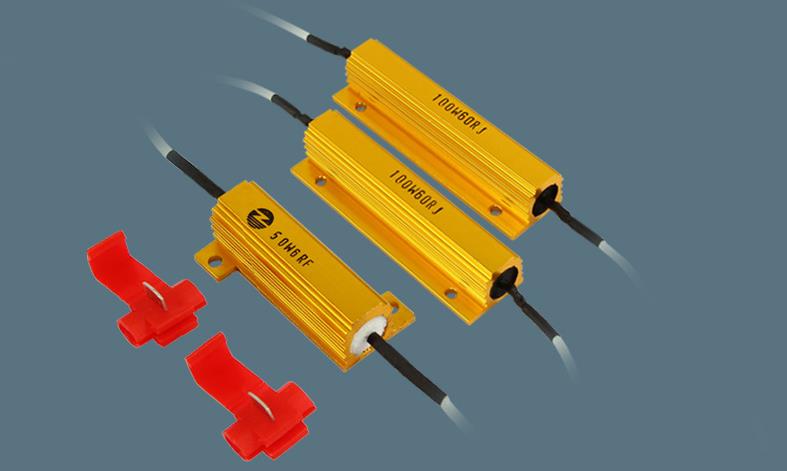What are the types and special features of high power wirewound resistors ?

Small and medium power universal frequency converter is generally voltage type frequency converter, using AC - DC - AC working mode. When the frequency converter is just powered on, because the filter capacitor capacity of the DC side is very large, the current is equivalent to short circuit at the moment of just charging, and the current will be very large. If there is no charging resistance between the rectifier bridge and the electrolytic capacitor, it is equivalent to the 380V power supply directly short circuit to the ground, and the rectifier bridge will blow up at the moment through infinite current. In addition to the charging resistance current limit, if there is no relay or other components, charging resistance consumption of power is also very large. For example, for a 22kW frequency converter, there is at least 45A current on the PN end (DC bus). If there is a problem with the "connection control circuit" part (such as the quality of the relay or thyristor etc.) the charging resistor will fail due to heat after running the converter for a while. So the charging resistor is connected in series in the charging loop, and the current limiting charging occurs at the moment of energizing, so as to protect the function of the rectifier and other input loop devices. Some books are also called buffer resistors or starting resistors.
After charging, the control circuit will short circuit the resistance through the contact of the relay or the thyristor to complete the power on process of the frequency converter. If the AC input power supply of the frequency converter is frequently on and off, or the contact of the bypass contactor is poor or the conduction resistance of the thyristor is larger, repeated charging or charging time is too long will lead to the charging resistance burning out. Therefore, before replacing the charging resistor, we must find out the reason before putting the frequency converter into use again.
But some inverter during startup CPU is a voltage detection and frequency reduction action, if the contactor coil lead terminal loose cause poor contact, contact failed to suck, the large current when starting form a larger pressure drop in the charging resistance, main circuit of dc voltage drop sharply detection by voltage detection circuit, the CPU will make frequency reduction instructions, In no load or light load, the detection circuit will be undervoltage fault "timely report", the CPU immediately stop protection. The resistance is too late to burn off, the frequency converter has stopped protection.
So, how to choose the resistance value of the charging resistor?
After 380V AC rectifier, the electrolytic capacitor is charged through the charging resistor. When the charge reaches a certain value (such as DC200V), the auxiliary power supply starts to supply power to the control board, so that the control board works and the relay or thyristor is connected. The charging resistor will no longer work. At the moment of starting up, the lower the charging resistance, the greater the current will flow through the rectifier bridge. There are often beginner frequency converter maintainer calls to consult, replace the charging resistance, the inverter is turned on, the rectifier bridge will be blown up immediately, is the charging resistance selection too small? The answer is no.
In fact, at the moment of starting up, in general, the reason why the rectifier bridge is blown up after starting up is not that the selected charging resistance R is small, but that the R is too large, which leads to the explosion of the rectifier bridge. After the inverter starts up, the electricity flows through the charging resistor to charge. When the charged electricity is enough to start the auxiliary power supply (such as 200V), the CPU will work and send a signal to the relay or thyristor to enable it to conduct. At the moment of relay conduction, the voltage at point B of relay is very low (greater than 200V), while the voltage at point A is AC380V, which is directly rectified around DC540V, so the pressure difference between terminals A and B is very large. At the moment of triggering and conduction, the current is very large, just like a small resistance between A and B. At the moment, several hundred volts of voltage are added, so the current flowing through the rectifier bridge is far greater than the rated current of the rectifier bridge, so the rectifier bridge is blown up.
The greater the power of the frequency converter, the smaller the charging resistance. Because the greater the power of the frequency converter, the greater the capacity of the electrolytic capacitor is needed, and the greater the capacity of the capacitor, the longer the charging time is needed. RC determines the charging time. If the charging time is to be as short as possible, the charging resistance R is to be as small as possible. General charging resistance selection: the maximum value should not exceed 300Ω, the minimum value should be greater than or equal to 10 ", the charging resistance of high-power frequency converter is small, and the charging resistance of low-power frequency converter is large.
“Recommended reading”
- What are the characteristics of aluminum resistors?
- 电阻器如何运行和工作?
- How to choose the resistance value of the charging resistor?
- 什么是导致预充电阻损坏的原因?
- How to improve the aluminum shell resistance compliance product quality!
- Stable and adjustable high power corrugated and wound resistors!
- Application and characteristics of cement resistance
- Power wound resistors and the basic introduction of several resistors
- Precautions when using resistors
- Classification and main characteristic parameters of resistors
Recommended information
- 正阳兴生产的负载箱应用的领域和特点!
- ZENITHSUN Production Site-1
- ZENITHSUN Production Site-2
- ZENITHSUN Production Site-3
- ZENITHSUN Production Site-4
- Load Bank Assembly Site -1
- Load Bank Assembly Site -2
- ZENITHSUN Load Banks Assembly Site-3
- Load Banks Batch Assembly Site-4
- Load Bank Assembly Site -5




